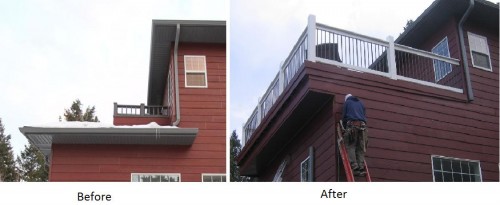From time to time EVstudio is asked about the feasibility of retrofitting an existing deck to accommodate a hot tub and in some cases to design a deck for a hot tub on a new project. Here is some basic background information on the structural implications. Keep in mind every project varies and EVstudio can provide a thorough analysis of your existing or future conditions if you are considering such an endeavor.
Although the deck’s structure is hidden from view in the above example, this was a project in Clear Creek County that EVstudio designed a deck addition for which the owner had a small existing deck above his garage and wanted to retrofit the home to accommodate a hot tub.
Well right off the bat it should be known that water itself is relatively heavy, being 8.35 lb per gallon or 62.43 lb per cubic foot. Then there is the weight of the empty hot tub itself, which can range quite a bit depending on the manufacturer. For this example I’ll use a larger than average size tub of 8’x8’ that can accommodate 6 people and weighs 550 lb when empty. And the volume of water for this tub is 500 gallons. So the water alone weighs a total of 4,175 lb. Then you have to include the live load of people. Yes, the hot tub was intended for 6-8 people, but you must still consider the situation of people overloading the intended occupancy, therefor use the floor live load used for the rest of the deck, typically 40psf for residential. If the hot tub occupancy is overloaded, the volume of water would be displaced and possibly reduced if the water spills over the edge. Be careful assuming this and reduce the water load or live load at your own discretion. The total anticipated weight of the tub and water equals 4,725 lb. So given that the tub is 8’x8’ a value of almost 74 lb per square foot (psf) plus the floor live load of 40psf for a total of 114psf is the basis for which one would need to design the deck. Most hot tub manufacturers should be able to supply you, your engineer or architect with a pound per square foot value of the tub and water, but probably would not include the occupant load.
To provide some perspective on this 114 psf value, decks without a hot tub are designed with a floor live load of at least 40psf or the snow load for a particular locale if greater than 40psf, which can be obtained by contacting your local building department. For example, a residence in a particular area of Evergreen, CO needs to be designed with a 50 psf snow load (greater than the live load of 40psf), otherwise known as roof snow load. So, to add a hot tub to the equation, one would need to add the 74psf hot tub load to the 50 psf of the snow load for a toal load of 124 psf. You must still consider snow load on top of the hot tub. However you don’t have to consider the 50psf snow load and the floor live load at the same time.
If the local building department allows load duration factors you can value engineer the deck using a load duration of 1.15 for the snow load, but you must still use a factor of 1.0 for the floor live loads and hot tub.
Another thing to be careful of is the location of the hot tub on the deck. Keep in mind you may design a specific area for a hot tub, but how is the homeowner to know he/she can’t move the hot tub to the other side of the deck.
Something to consider when incorporating a hot tub in your deck.









